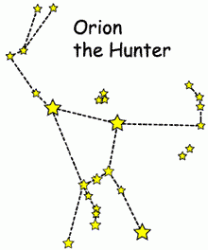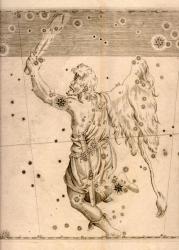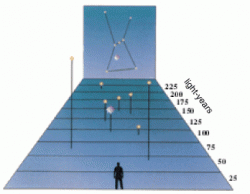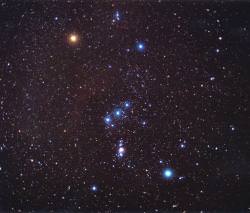Do you have children or grandchildren? Perhaps a younger brother or sister? Then, there is no greater gift which you can give them than to pass on the love of the starry skies. Right now, one of the easiest constellations to recognize – Orion – is a cinch to find for both the northern and southern hemisphere. Let’s take advantage of the weekend’s early moon-free skies as we take the young folks out to look for Night Lights and practice some astronomy for kids!
 To begin learning about our Universe, all you have to do is look up at the night sky. After all, that’s how astronomy began! When humans first began to notice the stars, the saw patterns they could easily remember. These patterns are called asterisms. In ancient times, there was no television or video games – so people began to make up stories about the asterisms they saw in the stars. Just like a game of “connect the dots”, asterisms represented legendary people – or even animals! One of the most famous of all is Orion the Hunter. All the old stories tell that Orion was an excellent hunter whose memory is captured in the stars. If you look above his bow you will see stars of Taurus the Bull and underneath his feet are the stars of Lepus the Rabbit. Both of these asterisms were animals he chased! But no hunter is complete without his faithful hunting dogs. The bright star following behind Orion is Sirius – a star which is part of an asterism that represents a big dog.
To begin learning about our Universe, all you have to do is look up at the night sky. After all, that’s how astronomy began! When humans first began to notice the stars, the saw patterns they could easily remember. These patterns are called asterisms. In ancient times, there was no television or video games – so people began to make up stories about the asterisms they saw in the stars. Just like a game of “connect the dots”, asterisms represented legendary people – or even animals! One of the most famous of all is Orion the Hunter. All the old stories tell that Orion was an excellent hunter whose memory is captured in the stars. If you look above his bow you will see stars of Taurus the Bull and underneath his feet are the stars of Lepus the Rabbit. Both of these asterisms were animals he chased! But no hunter is complete without his faithful hunting dogs. The bright star following behind Orion is Sirius – a star which is part of an asterism that represents a big dog.
 As time passed, astronomers began to make maps of the asterisms they recognized and the names on the maps became constellations. The night sky soon began to be filled with constellations and many even shared the same stars! To keep things in an understandable order, a group called the International Astronomical Union made a rule that only 88 asterisms could be called a constellation. This doesn’t mean the stars of a constellation are easy to see or what they are supposed to look like makes sense! Don’t worry if it is harder to see some constellations than others, because what we see here on Earth isn’t how the star patterns would look from a different place in our galaxy.
As time passed, astronomers began to make maps of the asterisms they recognized and the names on the maps became constellations. The night sky soon began to be filled with constellations and many even shared the same stars! To keep things in an understandable order, a group called the International Astronomical Union made a rule that only 88 asterisms could be called a constellation. This doesn’t mean the stars of a constellation are easy to see or what they are supposed to look like makes sense! Don’t worry if it is harder to see some constellations than others, because what we see here on Earth isn’t how the star patterns would look from a different place in our galaxy.
 Now, let’s take an imaginary journey into space…
Now, let’s take an imaginary journey into space…
The asterisms we see in the stars might look close together from our point of view, but if we could fly by them or see them from from another solar system they would all appear very far apart. If we were able to journey past the stars in Orion, we would see they really aren’t even connected to each other – or even close! If you take a look at this illustration you can get an idea of how far apart the stars of Orion really are looking at them from Earth. While they make a pattern in the sky, they are very far apart in space!
If you live in the city, you will probably be able to see many of the stars that make up the constellation of Orion – but if you drive to the country you will be amazed at all the stars you can see with just your eyes. Practice finding Orion the Hunter and see how many of its stars you can see. In just a few weeks, you can take part in a very exciting science study where you will become a Star Hunter!


Good idea!
I have published my translation into Spanish in my blog, at http://elatrildelorador.blogspot.com/2008/02/descubriendo-orin.html
Thanks!
Very good presentation for kids of all ages.
i hate ur website
no gd info